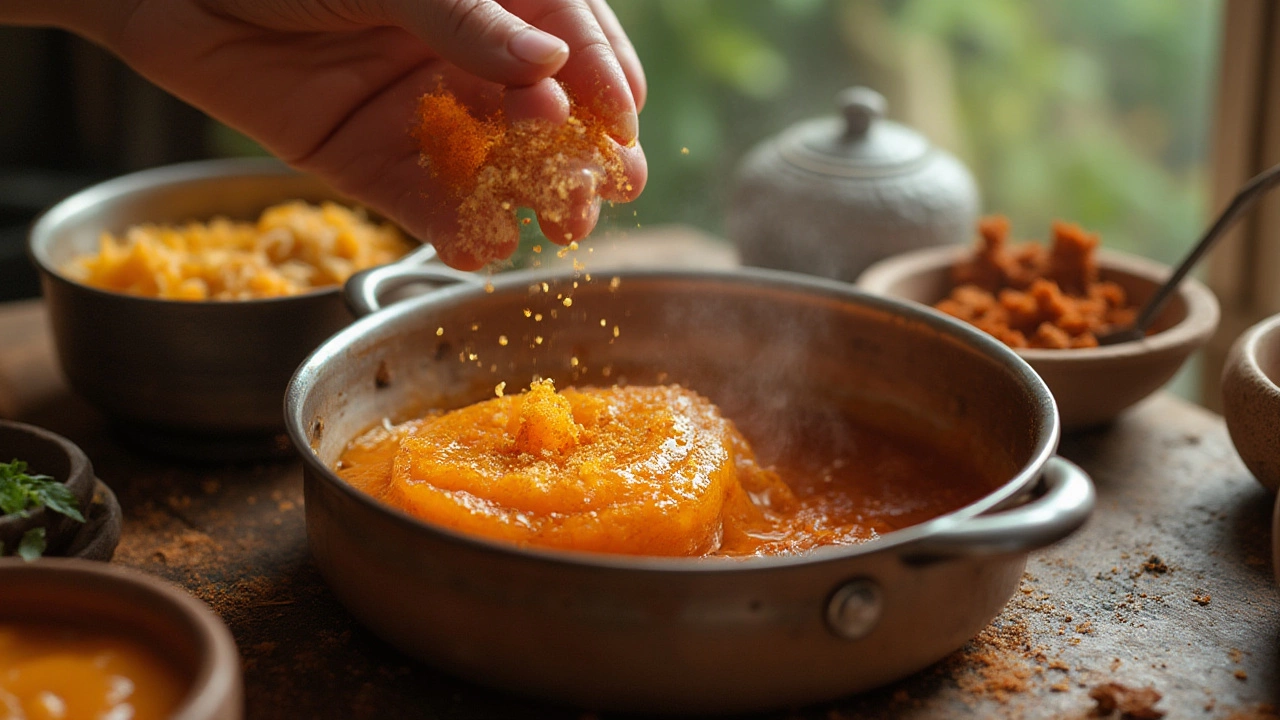Did you know that a watery chutney can ruin those dreamy paratha bites or crispy samosa dips in less than a second? Runny chutney isn’t just a little disappointing—it actually tells your taste buds that something’s off. The right consistency isn’t just for looks. It helps chutney cling lovingly to whatever you’re dunking and makes every spoonful hit differently. If you’re tired of seeing your perfect mango chutney sliding off the spoon or your spicy green chutney pooling sadly on the plate, you’re not alone. Many cooks—beginners or pros—have faced the wobbly, thin chutney dilemma. But what makes chutney thick in the first place? That’s where thickening agents step up.
Why Chutney Consistency Matters: The Science and Joy of a Good Dip
No one dreams of serving a bland, watery chutney. Ever noticed how restaurant chutneys always seem perfectly smooth and spreadable, never thin or runny? That consistency isn’t accidental. Chutney is meant to balance flavors—sweetness, tang, spice—and its body matters almost as much as the taste.
Runny chutney happens for several reasons. Sometimes it’s because fruits or vegetables let out too much water (hello, watery tomatoes), or maybe the recipe just doesn’t simmer long enough. Even humidity can mess with your kitchen game. The goal is to land that lovely middle ground—spoonable, glossy, and thick enough to stick to snacks without being gloopy. Serving chutney that’s too thin can make dishes soggy, and honestly, it just doesn’t deliver that punchy experience.
Let’s talk a bit of science: thickening happens when you either reduce water through simmering or add something that soaks it up or helps ingredients gel together. You want a substance that’s subtle, doesn’t overpower flavors, and gives structure. This is where our thickening agents—some classic, some surprising—come in.
Classic Indian Thickening Agents: Time-Tested Favorites
Traditional Indian kitchens know all about quick fixes for runny chutneys without fancy or chemical-laden additions. Most homes keep a mental list of go-to tricks—and they work for every type, whether it’s tamarind chutney, coconut, coriander, or even piquant mango.
- Besan (Gram Flour): This is a staple in Indian pantries for a reason. Lightly roast a teaspoon or two of besan and whisk it into warm chutney. It’s tasteless once cooked in and helps absorb excess water. You must keep stirring, though, or it might get lumpy.
- Cooked and mashed potatoes are magic for thickening chutneys with a mild flavor, like mint or coriander. They blend in easily, lend a creamy mouthfeel, and don’t fight the original taste. A small boiled potato, mashed fine, can fix a whole batch.
- Bread crumbs (yes, for chutney!): A handful added to the pot, mixed well, absorbs moisture almost instantly. This trick is especially good for chunky chutneys or if you’re short on time.
- Coconut: If you’re making something like coconut-coriander chutney, extra grated coconut works both as a thickener and for added flavor. Toasted coconut also releases oils and firms up the texture.
- Tamarind Pulp: If your chutney is on the sweet side (think mango or dates), stir in more tamarind pulp for both body and balanced tang—just adjust sugar if it tips toward sour.
- Roasted peanut powder: This is a South Indian grandma favorite. Freshly ground peanuts add nutty flavor and help thicken even the runniest chutney in just a minute or two.
The cool thing? None of these options are wildly expensive or hard to find. They also allow you to tailor thickness by taste. Once you see the chutney start sticking to the spoon, you know it’s there.

Modern Kitchen Solutions: Easy Fixes for Home Cooks
Home cooks today have access to supermarkets, food science, and an entire cupboard of easy fixes. Want to try what the food industry uses for jams and sauces (in smaller, safe doses)? You can! There’s nothing wrong with a tiny bit of kitchen chemistry if it gets your chutney to dreamy perfection.
- Cornstarch: Make a thin slurry (one teaspoon in a tablespoon of water), then slowly pour into your simmering chutney and stir well. It thickens up as it cools.
- Arrowroot powder works like cornstarch but leaves chutney a little glossier. Use exactly the same way as you’d use cornstarch.
- Agar agar, a vegetarian gelatin made from seaweed, is loved for thickening fruit chutneys and adds zero taste. Dissolve a small pinch in warm water and whisk it in.
- Pectin: This is what gives jams their wobble. You’ll find pectin powders at baking supply stores, and a small amount can thicken chutneys fast—especially fruit-based ones.
- Chia or flax seeds, for health-conscious cooks: These seeds swell up and add body fast. Grind them for a smoother look or leave them whole for a bit of crunch and nutritive value.
Still worried about changing the flavor? Do a taste test! Start with small amounts, add slowly, and remember that thickening can keep happening as chutney sits and cools. And always check for salt or sugar after thickening, as the flavors can mellow out.
| Thickener | Type | Effect on Flavor | Best for |
|---|---|---|---|
| Besan | Natural, flour-based | Neutral if roasted | Herb chutneys |
| Potato | Vegetable | Mild, creamy | Pudina, coriander |
| Cornstarch | Refined starch | Tasteless if cooked well | Fruit chutneys |
| Peanut powder | Nut powder | Nutty, rich | Coconut chutney |
| Chia seeds | Seed | Earthy, mild | No-cook chutneys |
| Bread crumbs | Bread | Bready, mild | Quick chutneys |
| Pectin | Fruit fiber | Tasteless | Jammy, sweet chutneys |
Troubleshooting and Tips: Getting Your Chutney Just Right
So you’ve thickened that batch, but is it really right? Here are some straight-up, battle-tested tips from cooks who’ve fixed more runny chutneys than they care to admit.
- Always add thickeners slowly. A little goes a long way, and you can’t “unticken” a chutney once it’s too stiff.
- If your chutney is too thick after cooling, dilute with a little warm water or lime juice to freshen it up.
- If possible, simmer chutney gently without a lid. Natural reduction works wonders for pulling out big flavors and fixing thinness.
- Use a wide pan. The greater the surface area, the faster water evaporates. Think of kadai instead of tall saucepans.
- Chutney thickens as it cools—so aim for slightly runnier in the pan than you want in the jar.
- For sweet chutneys (like mango or pineapple), pectin and cornstarch work best. For herb chutneys, go for besan, peanut powder, or coconut.
- Want calorie control? Use chia seeds for extra fiber and protein. Just a pinch swells up a whole batch—and it’s trendy, too.
- If using flour-based thickeners, cook them in oil or ghee for 30 seconds before adding to chutney to remove raw flavor.
- Pair the thickener with the chutney type. Potato works great in mint but would just taste odd in sweet date chutney.
One thing most people miss: the container matters. Store chutney in a glass jar, cooled completely, and seal tightly. This prevents extra moisture from sneaking in and making your chutney runnier with time. Also, never freeze chutney with extra potato or bread—these can change texture on thawing.
Next time you’re eyeing that runny mess in the mixer, try out one of these trusty methods. Soon, you’ll have thickening agent for chutney as the least of your worries, and the most clingy, tasty chutneys at your table every single time.
